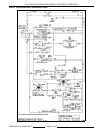
FULL SIZE GAS CONVECTION OVENS - ELECTRICAL OPERATION
F24682 (Rev. B, October 2007)Page 47 of 68
Roast Cycle (Normal Cooking)
1. Conditions.
A. Oven connected to correct voltage.
1) L1 (HOT) to power switch (S1).
2) L2 (NEUTRAL or SECOND LINE) to
one side of the following components:
oven cavity lights, convection fan
motor common (C), transformer
primary (T1), component cooling fan
and the heat relay coil (R1).
B. Oven properly grounded.
1) Ground (GND) to one side of the
following components: computer
control case, NO IGNITION light,
transformer secondary (T1), ignition
control module, the 1
st
valve (safety)
and 2
nd
valve (main) on the dual
solenoid gas valve and computer
control pin 9 (C3-9).
C. Gas supply valve ON.
D. Gas combination control valve ON.
E. Power switch (S1) OFF.
F. Computer control is setup properly and
ready to use.
G. Oven light switch (S2) ON/OFF (position
has no affect on the function of the ROAST
cycle).
H. High limit switch CLOSED.
I. Oven doors Closed.
1) Door switch contacts CLOSED.
J. Oven cavity temperature below 140°F.
2. Power switch (S1) turned ON.
A. Power (120VAC) to computer control pin 3
(C3-3).
NOTE: Power at pin 3 is not transferred to
other components until computer control is
energized and operating conditions are
met.
B. Power is available to the oven light switch
(S2).
C. Power to terminal 1 on solid state relay 1
(SSR1 -load side) and solid state relay 2
(SSR2 -load side).
D. Component cooling fan energized.
E. Transformer (T1) is energized.
1) Power (24VAC) to one side of the
following components: heat relay (R1)
normally open (N.O.) contacts, high
limit --- connected through the
normally closed (N.C.) contacts to the
1
st
valve (safety) on the dual solenoid
gas valve.
a. 1
st
valve (safety) on the gas valve
energized.
NOTE: Gas does not flow to the
burner until the 2
nd
valve (main)
is energized.
2) Power (24VAC) to the oven computer
control.
a. Control is energized and
performs a power ON self test
before energizing outputs.
NOTE: If the control passes self
test, then the outputs are
energized and operation
sequence continues. If control
does not pass self test then the
corresponding error code is
displayed.
b. Computer control senses oven
cavity temperature.
a) With the oven cavity
temperature below set point,
the controls 120VAC output
from pin C3-2 is activated
and power is connected to
the common (C) side of the
centrifugal switch contacts
on the convection fan motor.
NOTE: The set point
temperature of the computer
control will be the last
temperature that was set.
NOTE: Power is not applied
to the heat relay coil (R1)
until the centrifugal switch
contacts on the convection
fan motor close.
c. The controls 5VDC output from
pins C2-2 (-) and C2-8 (+) is
activated and SSR1 relay is
energized.
a) Convection fan motor is
energized (fan speed hi).
b) When the convection fan
motor reaches operating
speed, the centrifugal switch
(N.O.) on the motor closes.
3) With the 120VAC output from the
control activated and the centrifugal
switch on the convection fan motor
closed, power is applied to the heat
relay coil (R1).
a. Heat relay coil (R1) is energized,
(R1) contacts (N.O.) close and
the heating circuit is powered.
b. Oven HEAT LIGHT on the
control comes ON.


















